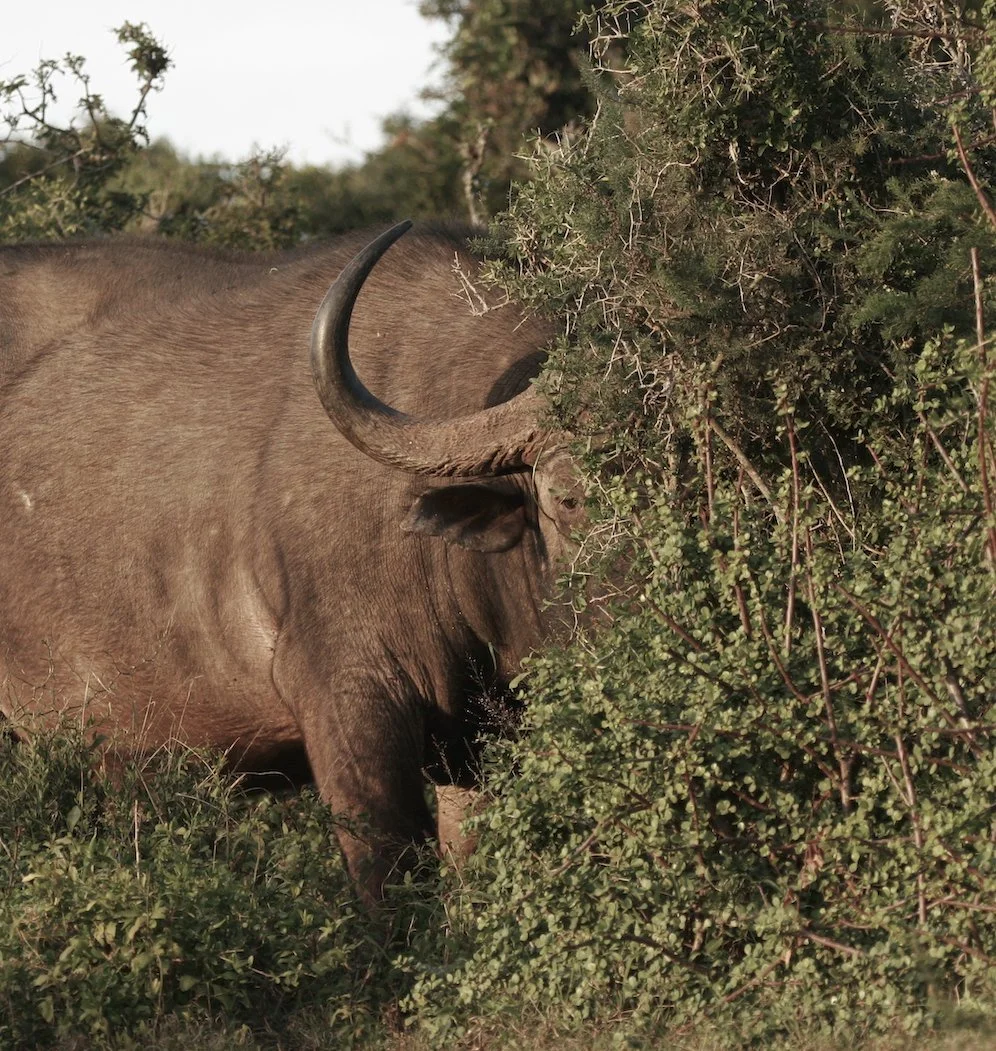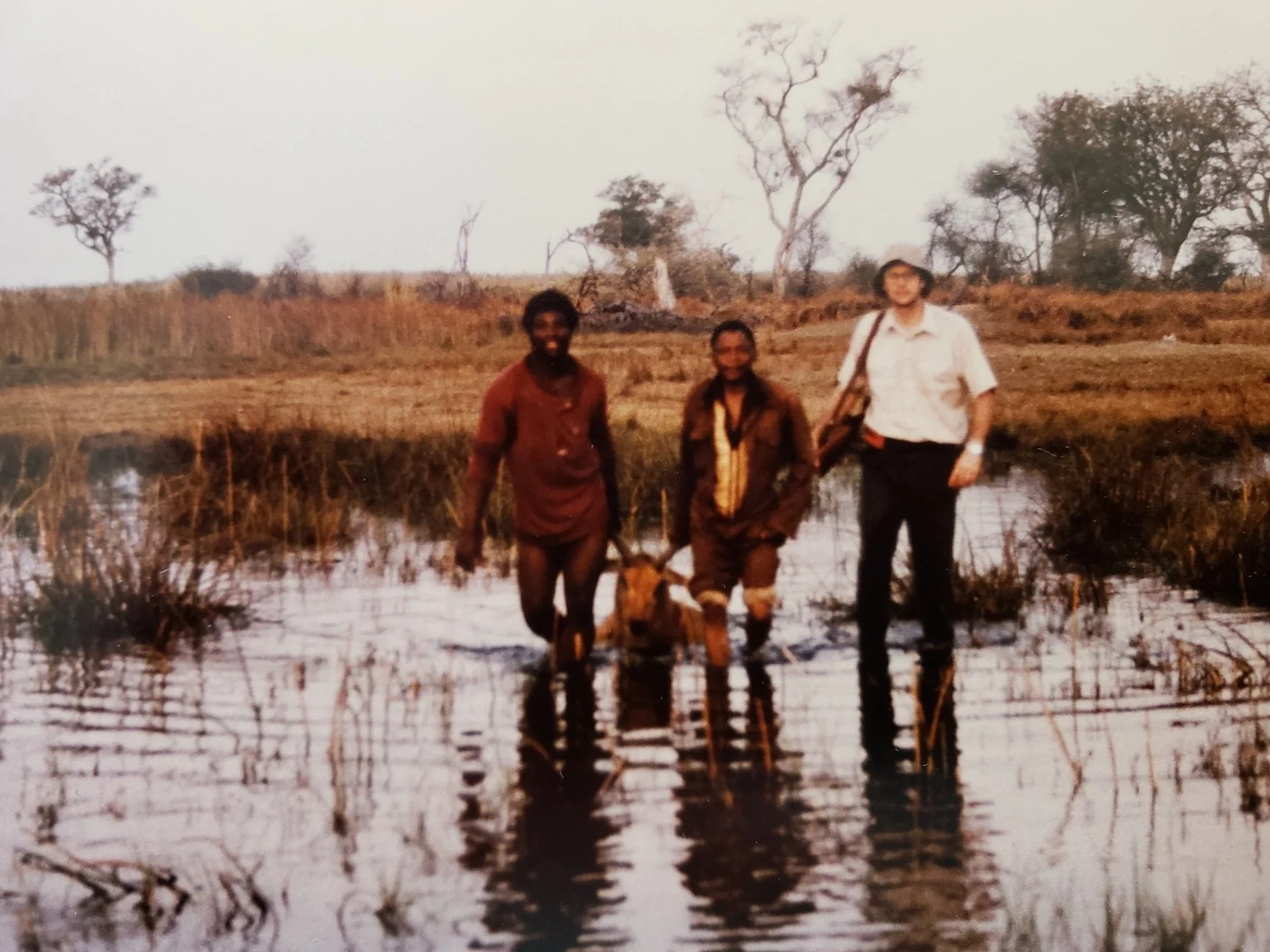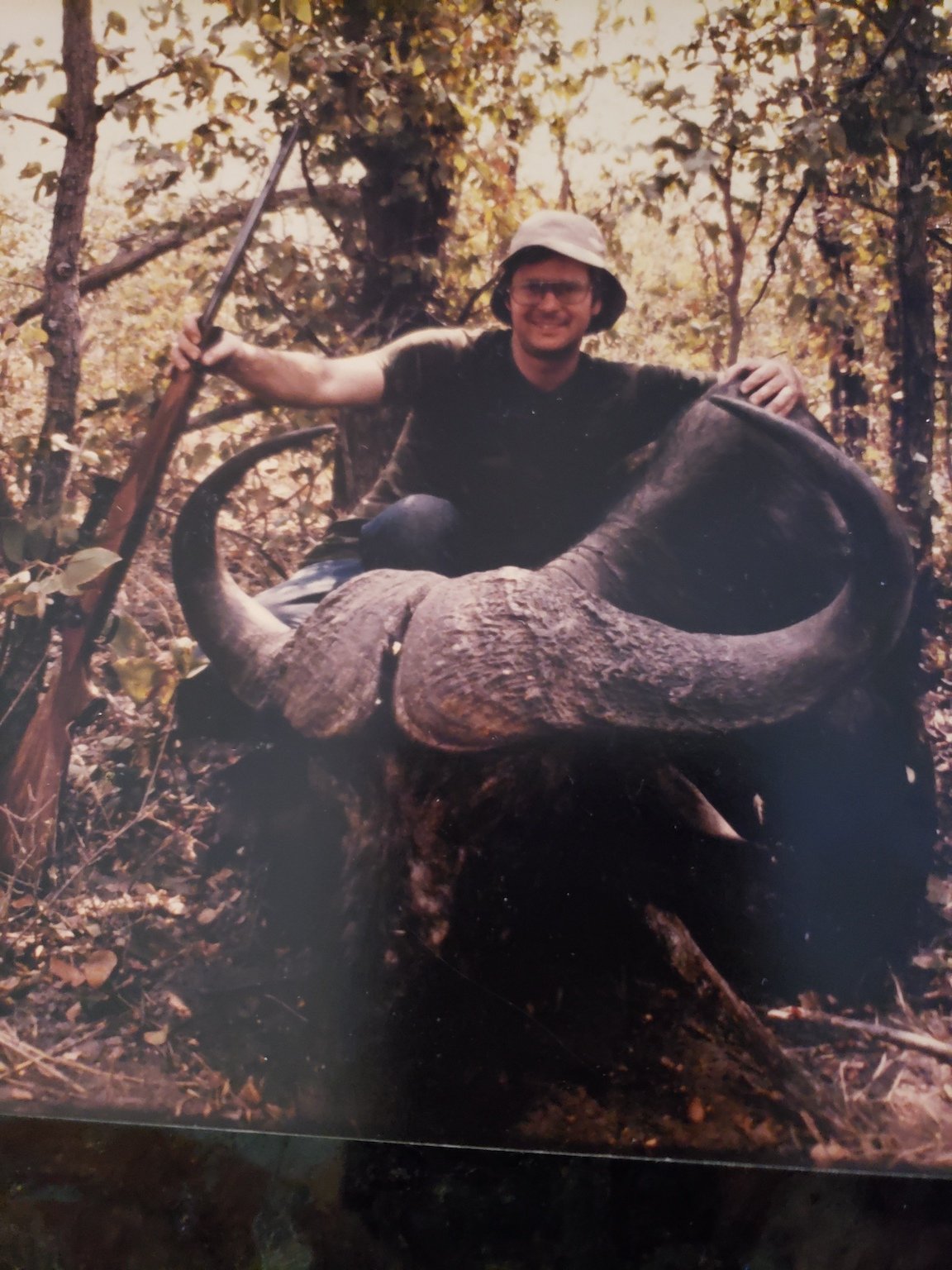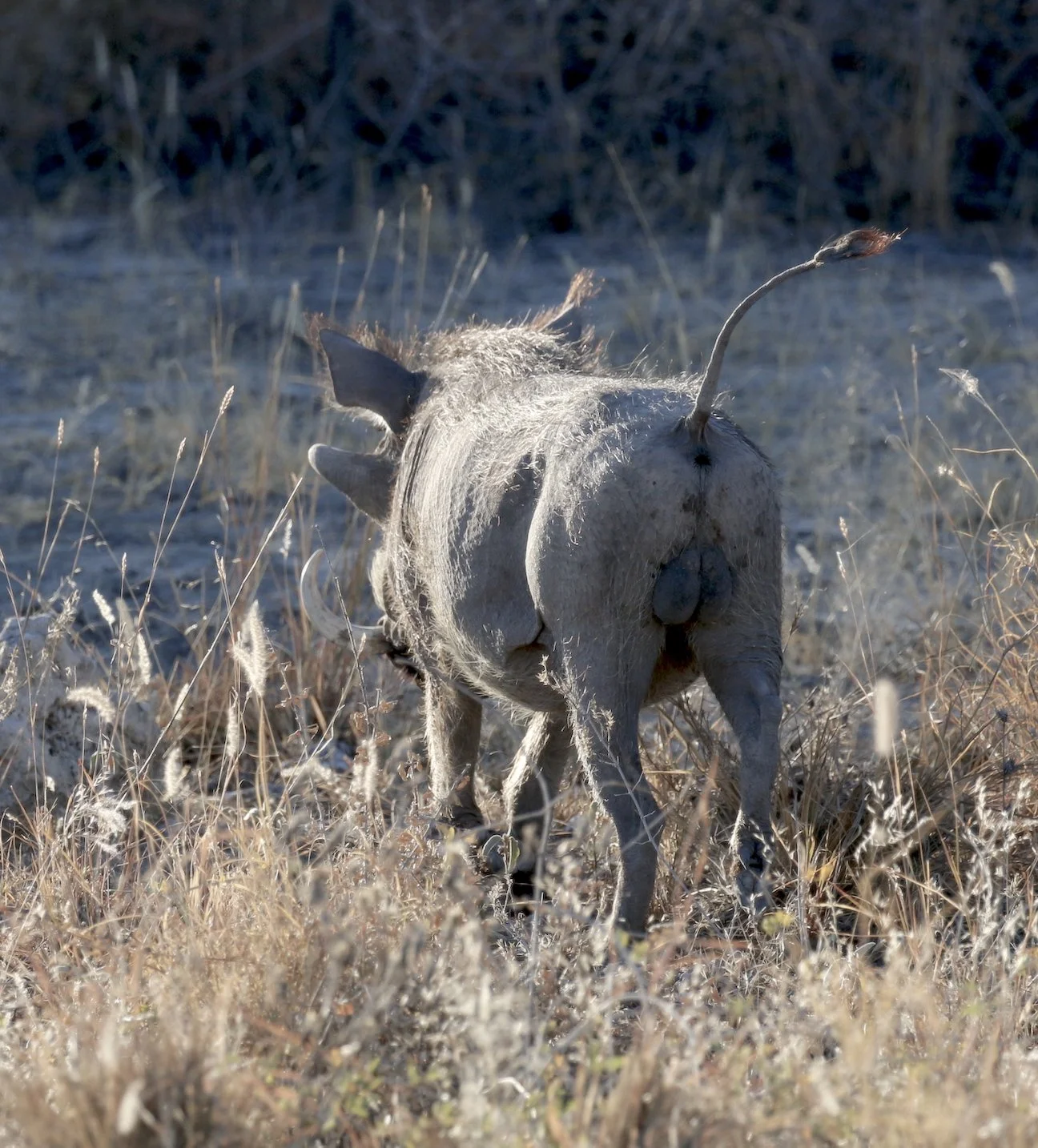Botswana Safari with “No Second Place Winner” Bill Jordan (Part 2)
African Hunting in the 1980’s Part 2 of 3 by Ed H. Edwards
A fine mess you’ve got yourself into ran through my mind while aiming my 460 Weatherby at a crippled Cape buffalo holed up in ambush less than 20 yards away.
Safaris are like a good potato chip; one is never enough! As soon as my first African hunt was finished, I started to plan the next. The Chicago-based agent who’d set up my first hunt recommended a Cape buffalo and plains game combination in Botswana or Zambia. Either would require a charter flight to a seasonal tented camp.
Almost two years went by and mounts from my first hunt were on barely on the wall the stars lined up for hunt number two. The company I was working for at the time had supplied equipment to Sasol, the South African Oil & Chemical Company. They were requesting some on-site service assistance. This was in 1984. South Africa was an international pariah in the news, so no one wanted to go. Not wanting to appear too eager, I volunteered with a sigh just for good measure.
Timing was perfect! My work at Sasol would be finished just as a group of hunters were coming transiting through Johannesburg to Botswana. I would be able to join them. The hunt was an 8-day buffalo and plains package in the Kwando River delta bordering the Eastern end of the Caprivi Strip. The flight up from Johannesburg to Maun was uneventful. The Maun airport at the time was a tiny one-counter terminal and hunters gathered at the Duck Inn a dusty fifty yard walk from the terminal before catching the charter flight to camp. Most of the diners were professional hunters meeting or seeing off. They were easy to spot in their large-caliber shorts, sockless boots, and large “culling belts” stuffed with cartridges.
We were on an end-of-season special hunt the outfitter offered to use up pre-purchased tags. Hunters were allowed one each: Cape buffalo, red lechwe, impala, and any two of either zebra, wildebeest, or warthog. The price for this hunt including all licenses, tags, charter flights and eight full days of hunting: $3,300.00!
I was also able to purchase a license for one tsessebe, a rare antelope at the time. Our two, four-passenger charter planes flew at low enough that I could see large herds of elephant, buffalo, and plains game right up to our final approach to the cut-from-the-bush landing strip.
Camp was in the heart of the game rich area and consisted of “Kenya” style tents, bucket shower, outhouse, and dining tent. Having plains game close to camp was enjoyable as lechwe, impala, and zebra could be seen all day. Getting to sleep was challenging due to elephants feeding on trees shading our tents and lions fighting over the nearby bone pile. This also enlivened nocturnal trips to the outhouse! We were not allowed to take walks away from camp due to the elephants constantly hanging around. Elephants had been off license for quite a few years and were big, plentiful, and fearless.
Elephants were plentiful and fearless.
The group in camp were diverse in occupations and hunting experience.
Frank, a surgeon from Louisiana, was on his second African hunt having hunted Southwest African (now Namibia} for plains game.
Dick, an oil distributor from Wyoming with a lot of experience in his home state was on his first African hunt.
Ralph, an assistant prison warden from Iowa, was on his first big game hunt of any sort.
Prior to the trip none of us had met and the trip was a 2 X 1 so it was decided I would team up with Ralph. Clive Eaton would be the PH for Frank and Dick. Willie Phillips would keep Ralph and me out of trouble.
Additional camp members included Paul Merzig, the booking agent, Shelia Link, a photographer, and Bill Jordan, a man with an interesting career in law enforcement, hunting, and journalism. Jordan was a career Border Patrol Officer with stints in the Marines during WWII and the Marine Corp Police during the Korean War. In 1965 Bill retired as Assistant Chief Border Patrol Inspector as well as Major in the Marine Reserves. Thereafter, he joined the NRA and had way too many positions and honors to list, but he’s most famously known as a revolver fast draw and trick shooting expert. Bill also wrote about firearms and hunting for several magazines including Peterson’s Hunting and Shooting Times. His book on police handgun shooting, No Second Place Winner, is a classic. Bill would hunt a buffalo and lechwe and write about it for Shooting Times.
Author Ron Spomer once described Bill as “a crane of a man.” That is a great description. At 6’ 6” with who knows what sleeve length and hands any NBA player would be happy to own, Bill was truly a gentle giant — as long as you behaved yourself!
Time spent with Bill at meals and around the evening campfire were a big part of the trip. Accounts of his border patrol work, favorite firearms, and hunting experiences were informative and entertaining.
The story I found most interesting occurred in a Wyoming courtroom in 1979. Bill was called in to participate in a “reenactment” of a law enforcement officer shooting in self- defense. The defense attorney wanted to prove it was possible to draw and fire a double action revolver before someone holding a cocked revolver could fire. The attorney came up with blanks for Bill and a deputy sheriff that was guarding the courtroom. The deputy was instructed to point the cocked revolver at Bill and to fire as soon as he saw Bill start to draw his gun. After a few moments Bill drew and fired. The deputy’s mouth dropped open as he stood holding the unfired gun.
The attorney asked Bill how fast his defendant was. “A mite faster than me” Bill replied. (Both Bill and the defendant had competed in shooting exhibitions for years.)
The jury found the defendant not guilty!
Now, on to the hunt.
Day #1: My first opportunity of the trip was a fine lechwe ram near dusk that looked really distant through the 4X scope, but the professional hunter urged me to shoot. Following safari hunting rule #1 I did exactly that. The 270 put the ram down but not quite out, so I had to walk and wade with the trackers across the soggy flat to finish it.
Dragging home the red lechwe.
Day #2: A non-hunting day for me. Ralph would hunt his buffalo and I would observe. Buffalo were plentiful and herds so large it was difficult to pick out a mature bull before they thundered off in a cloud of dust. After five or six failed attempts we had the wind right on a small herd of twenty or so that did not notice our presence. Most were directly in front or to the right of our position and the PH and tracker were focused on those. I spotted a single bull to our left that looked good and nudged the PH to check it out. He immediately motioned Ralph to shoot! Ralph smacked the bull with the 460 Weatherby Magnum, then follow up with two more as it galloped away. After about five minutes the MMMMMBAAAAWWW death bellow of the 44” bull sounded! Hunting buffalo did not seem to be that big of a deal, but I would find out differently on day #3.
Day #3: Finding buffalo was not a problem. Choosing and shooting the right one remained a challenge. In one herd we spotted a big bull that had a stub tail that was easy to keep track of but this apparently was not his first rodeo. After we followed a bit, he decided to take off in the opposite direction the herd was moving. And he did not slow down.
Later in the afternoon another big bull moved away from a small herd we were watching. He slipped behind thick brush. I could make out his hindquarters as he faced away at a sharp angle. Taking quick aim for a raking shot, I pulled the trigger. A meaty whack echoed from the 510-grain Hornady soft point finding its mark. The bull whirled into the thick cover and disappeared. The PH was confident the bull would not go far and we would find it dead from that single shot. He took time to smoke a cigarette, a common practice in those days, to allow the animal time to bleed out. He was so confident that he left his rifle in the truck!
The path the buffalo took was nearly impossible to walk through. Visibility as short, but we soon spotted the bull very much alive and standing in the shadows of scrub mopane. An ear wiggle had given him away at less than 20 yards. Time seemed to freeze!
I wasted no time swatting him in the chest. At the strike he kicked up like a bucking bronc. I cycled the bolt after recovering from recoil and as soon as the bull’s front legs came down to earth his neck was in the crosshairs. I swear my finger pulled the trigger before my brain sent the message to do so. The bull collapsed without any further excitement. This was okay with me!
We could not get the truck close to the downed bull and we had to field dress and cut it into six pieces to carry out. Other than having a surprise visit from T. Boone Pickens when we returned to camp, that ended the excitement for day #3.
Day #4: Ralph decided to have a portion of his trip filmed by Shelia so it was determined he would continue to hunt with Willie Phillips for the next three days. I would switch over to Cecil Riggs. Cecil land I began by looking for a tessebe, a clumsy appearing animal with high shoulders and touted to be the fasted hoofed African animal. In mid-morning I took a shot at a ram. Cecil called a gut shot and suggested we follow up using the truck— after he’d smoked a cigarette. The shot was not as bad as called and had caught a lung. We found the tessebe less than 100 yards away standing under a tree and I was able to put it down for good. The tessebe was good one and measured out in the SCI top 25 at the time and provided camp with delicious steaks.
Day #5: I’m down to impala and warthog. We spot a nice impala ram and make a good stalk and I miss by shooting right over its back. “No problem; we will find a better one,” Cecil assured me. And we did exactly that. This time I double lunged the ram and it back peddled several steps before dropping in a little clearing surrounded by tall grass. Approaching the downed impala, we got a surprise. As we low geared up to the ram three lionesses and a young lion lifted their heads less than 30 yards from the vehicle. After a few seconds stare down the lionesses decided to look for a different place to relax and scooted away. The lion stood up and gave us a really nasty look for disturbing the party. Cecil grabbed his 458 Win. Mag., jumped from the truck and screamed “Are you a fighter or b-s-rd?” and ran towards the lion. Turned out it was a chicken. It ran off after its his lady friends. Never a dull moment in Africa.
Day #6: Warthog were abundant but a good tusker required a lot of looking and rejecting many with tusks broken from rooting in the hard rocky ground. Warthogs are a favorite food source for the many lions and leopard that inhabited the area. This further reduced our pool of candidates. We looked all morning without seeing anything of interest and headed back to camp for lunch.
In early afternoon Cecil released the clutch and we rolled out of camp in a cloud of dust, headed in the opposite direction from the morning. Soon we spotted a sounder of warthogs in a recently burned area. They gave use a few seconds to look them over before spooking and running for cover. “Front one!” Cecil shouted. I swung the crosshairs about a body length in front of the chosen one and squeezed off at the same time the warthog disappeared into the tall grass. The sound of the bullet finding purchase and the warthog jumping up and reappearing before expiring on the spot brought uncontrollable laughter from the trackers who had never before witnessed an unseen animal shot!
Running warthogs.
I’m not sure if this qualified as my best shot, luckiest shot, or strangest shot. Perhaps it was all three. I do know it is an African hunting memory I will never forget.
We spent days 6 and 7 in camp, but indulged a little riding around in an area of the concession that had not been hunted for several weeks. We found a dead cow elephant that had a pride of lions feeding on it from the inside out. As we approached, lions shot out of that elephant carcass like rockets from an underground bunker.
This was truly the hunt of a lifetime. Many of the friends who shared it with me have since passed, but I remember them and our adventures fondly.
Shortly after the Botswana hunt, Bill Jordan’s article appeared in Shooting Times. It was reprinted in his 1987 book Mostly Huntin’ which is a collection of his favorite articles from Peterson’s Hunting and Shooting Times. It was truly a privilege and honor to spend time with a true American Legend.









